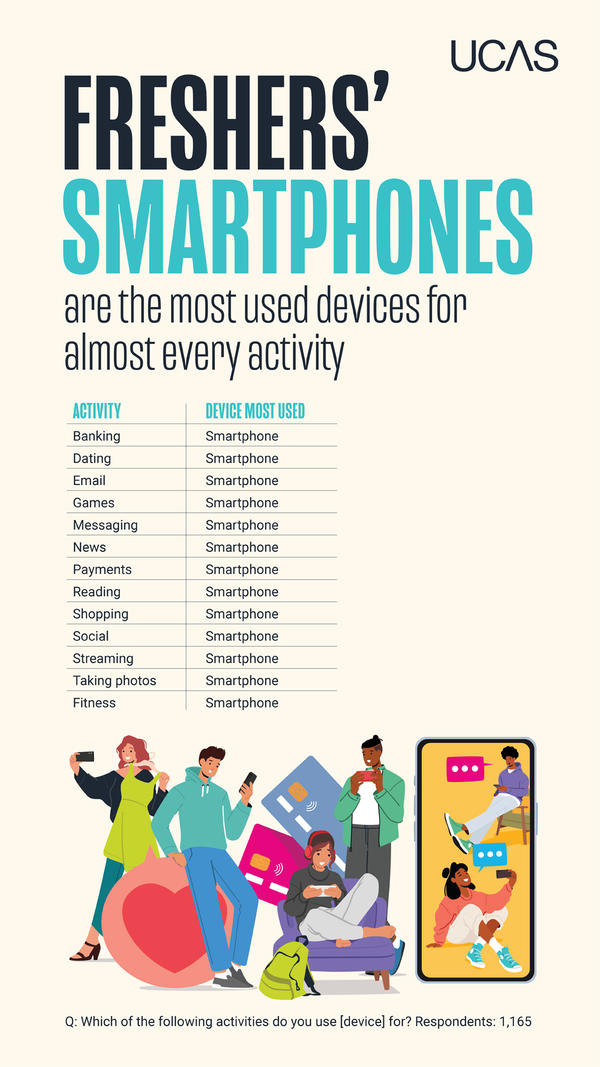Almost half of all students now own one, and tablets have become the second most popular new purchase for university, bought by double the amount of students compared to 2019. Usage has switched from streaming, shopping, and social – to note-taking, reading, and email. (No surprises for guessing which brand has the market sewn up here, with Apple outselling Samsung by almost 10x, despite being significantly more expensive.)
But why are students, amidst a rising cost of living, splashing around £700 or more on a tablet for activities they can do on their laptops (which 91% of them already own, and 48% buy new for university)?
Well, a few reasons:
- Fashion. Apple products, tablets, and tech in general, are as much a style statement as they are a functional purchase. There’s an element of keeping up with the Joneses at play here. It’s a flash device to own.
- Differentiation. It’s easy to write tablets off as miniature laptops, but they do carry specialist abilities. Being touchscreen as standard for one, which means more accurate sketching, drawing, and designing with styluses. They’re also a lot more straightforward than a laptop, for students who don’t need all the extra functionality, and appreciate the mobility and lighter load.
- Experience. We know from our UCAS Student Lifestyle Report that students would rather find ways to earn more or make their money go further (via part-time jobs, bargain-hunting, and making sacrifices in other areas) than give up on the uni lifestyle they’ve been planning for. Having the right kit is part of that lifestyle.
It’s the same story for smartphones
They are, on average, £126 (23%) more expensive than they were in 2019 – but ownership is only rising. The iPhone is notoriously pricey, but despite Samsungs being £307 (39%) cheaper, there’s no contest in market leadership. Retailers selling iPhones (and iPads) are, it seems, onto a surefire winner. In some ways, when it comes to buying an Apple product, price really doesn’t matter.
But in many other ways, of course it does.
40% of students are actively searching for offers and 29% are waiting to find one before they buy. Fewer students are buying brand new too, and more are buying both second-hand and refurbished handsets. More have cheaper SIM-only deals (26%) than ever, and fewer have the pricier monthly contracts – the gap between these two ends of the spectrum has closed by 10% over the last few years. For students, it’s a case of thou shalt have a smartphone by any means necessary.
You can see this in the choice of network provider too, where virtual providers (like Tesco, BT, and VOXI) are making gains on the big four (Vodafone, O2, EE, and Three.) The smaller networks pay to use the infrastructure of the bigger players, which means they don’t have to recoup big investments from their customers. Cheaper monthly bills mean more free cash to spend on the handset itself. Thou shalt have.
It’s curious then, that price is the second most important aspect when it comes to smartphone ownership. Price is more important than features, storage, camera, data, and even the brand itself. The only thing that beats it is battery life. And for good reason, because students tell us that most of their internet activity takes place on their smartphones. It’s the most used device for almost everything:

There’s only one exception across the 19 activities we track – laptops are used more than smartphones for note-taking. Optimising for smartphone-first experiences is now the modus operandi of any brand engaging with Gen Z.
But with price being such an important decision-making metric, time will tell whether the ownership of such expensive smartphones (and other tech) sticks – as the cost of living squeezes student and parent pockets alike.
This leaves some big questions that need answering
How much longer can students continue defaulting to a tech budget that stretches into the thousands, to own the holy trinity of smartphones, tablets, and laptops?
At what point does the fashion statement trump finance?
And with only so many hours in the day to get creative with their budgeting and earning, what else can students realistically do if prices keep going up and disposable income keeps going down?
And most importantly, how can tech brands keep pace with the shifting sands of user behaviours – and keep their marketing machine running in the face of so many changes of direction?
How brands can solve these challenges
For brands looking to understand Gen Z’s unique and constantly evolving relationship with tech, UCAS offers unrivalled partnership opportunities.
From data and insight to direct access to the UK’s student community through trusted channels, UCAS helps brands connect with youth audiences and gain loyal new customers. Need to discuss your needs in detail? Get in touch with the team to start the conversation: commercialservices@ucas.ac.uk